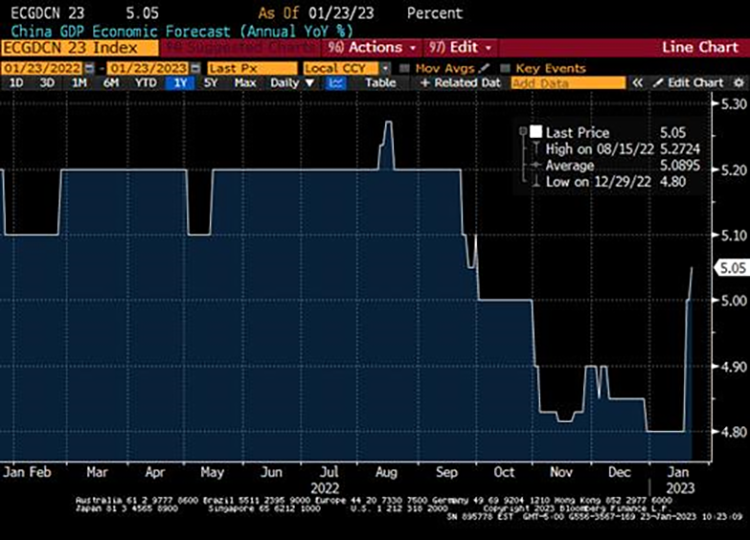Global Growth – Peak Pessimism?
23 January 2023
Read Time 2 MIN
FED Rate Cuts
We are only one week away from the U.S. Federal Reserve’s (Fed) rate-setting meeting, and growth is back in focus. The consensus expects a robust Q4 GDP print in the U.S. later this week (2.7% quarter-on-quarter annualized) but not much improvement in more forward-looking activity gauges (Purchasing Managers Indices). The latter explains why this year’s growth expectations for the U.S. are still well below 1% (the nascent uptick notwithstanding). The Conference Board’s leading index – which dropped more than expected in December (-1%) - signaled that such caution is not unreasonable. A combo of “barely there” expansion and continuing disinflation is the reason why the market (Fed Funds Futures) continues to price in U.S. rate cuts (45-50bps) in the fall – despite the Fed’s protestations.
China Rebound
Improvements in the near-term growth outlook for China are more justified, following the policy U-turns in the pandemic control and the real estate sector. China’s economic surprise index went ballistic in the past few weeks, the official manufacturing and services PMIs are expected to move to an expansion zone in January, and the 2023 growth forecast is now back above 5% (see chart below). Emerging market (EM) Asia is widely expected to benefit from China’s rebound – both in terms of growth and capital inflows/tourism recovery – and these expectations are already driving the regional FX performance, which boosted EM Asia local bonds’ total return (J.P. Morgan’s GBI-EM Index) above higher-yielding LATAM bonds so far this year.
LATAM Political Noise
And talking about LATAM, there is never a boring day in the neighborhood. I am sure many of you were entertained over the weekend by reports that Argentina and Brazil are planning a new common currency (called the sur). But jokes aside, policy and political developments in the region warrant attention because the growth is expected to decelerate very sharply in the coming months. Uruguay and Peru are the only major regional economies expected to grow by more than 2% in 2023. But if Peru’s social protests continue to intensify – hurting the country’s governability and tourism revenue – the GDP forecast will be cut, and bonds will continue to lag behind regional peers. Stay tuned!
Chart at a Glance: China 2023 Growth Forecast – Liftoff

Source: Bloomberg LP
Related Insights
IMPORTANT DEFINITIONS & DISCLOSURES
This material may only be used outside of the United States.
This is not an offer to buy or sell, or a recommendation of any offer to buy or sell any of the securities mentioned herein. Fund holdings will vary. For a complete list of holdings in VanEck Mutual Funds and VanEck ETFs, please visit our website at www.vaneck.com.
The information presented does not involve the rendering of personalized investment, financial, legal, or tax advice. Certain statements contained herein may constitute projections, forecasts and other forward looking statements, which do not reflect actual results. Information provided by third-party sources are believed to be reliable and have not been independently verified for accuracy or completeness and cannot be guaranteed. Any opinions, projections, forecasts, and forward-looking statements presented herein are valid as of the date of this communication and are subject to change without notice. The information herein represents the opinion of the author(s), but not necessarily those of VanEck.
The views contained herein are not to be taken as advice or a recommendation to buy or sell any investment in any jurisdiction, nor is it a commitment from Van Eck Associates Corporation or its subsidiaries to participate in any transactions in any companies mentioned herein. This content is published in the United States. Investors are subject to securities and tax regulations within their applicable jurisdictions that are not addressed herein.
All investing is subject to risk, including the possible loss of the money you invest. As with any investment strategy, there is no guarantee that investment objectives will be met and investors may lose money. Diversification does not ensure a profit or protect against a loss in a declining market. Past performance is no guarantee of future results.
